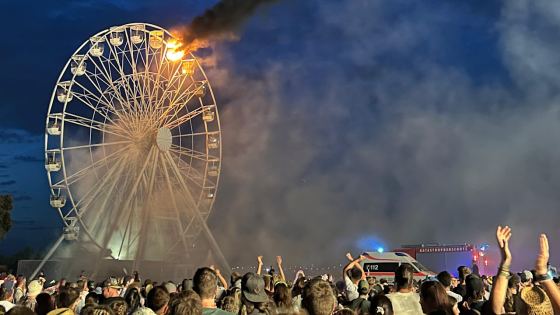Introduction
The Highfield Festival, an annual music event held near Leipzig, Germany, experienced a tragic incident that shocked attendees and onlookers alike. On Saturday evening, the festival’s ferris wheel caught fire, leading to chaos and confusion. The incident occurred around 8:30 PM, when the venue was bustling with festival-goers enjoying performances and festivities. As the fire engulfed the ferris wheel, more than 20 individuals were injured, requiring immediate medical attention.
Festival organizers and emergency response teams acted swiftly to manage the situation. Firefighters arrived promptly to extinguish the blaze and assist in the rescue operations. Panic ensued as people struggled to evacuate the area, leading to several non-critical injuries caused by the rush and overcrowding. The quick response by medical personnel helped stabilize the injured, many of whom were treated on-site, while others were transported to nearby hospitals for further care.
While the exact cause of the fire is still under investigation, preliminary reports suggest a possible technical malfunction. This unforeseen tragedy cast a shadow over the otherwise vibrant and highly anticipated event. Safety protocols and emergency preparedness at large-scale events like the Highfield Festival will likely be scrutinized as authorities work to ensure that such incidents do not recur in the future.
As the festival community, including attendees and performers, processes the aftermath, questions regarding event safety and emergency response readiness amplify. The incident underscores the critical importance of stringent safety measures and rapid, organized emergency interventions at public gatherings. Despite the unfortunate turn of events, the resilience and swift actions of the first responders highlight the community’s capability to handle unforeseen emergencies effectively.
Details of the Incident
On the evening of August 18, 2024, an unfortunate event unfolded at a popular music festival in Germany as a ferris wheel caught fire, leading to over twenty injuries. The incident is believed to have occurred around 8:45 PM local time. As dusk settled over the festival grounds, attendees were startled by the sudden eruption of flames on the iconic ferris wheel, which had been a central attraction.
According to preliminary reports, the fire appeared to originate from one of the carriages located near the apex of the ferris wheel. Within moments, flames engulfed two carriages, spreading quickly due to a combination of the high altitude and wind conditions. Eyewitnesses describe the terrifying scene, recounting how the sky filled with thick, black smoke and the sounds of crackling fire reverberated through the festival grounds. Screams of panic from riders trapped in the affected carriages added to the chaos.
Emergency services were immediately alerted, and the festival’s on-site safety protocols were enacted to manage the situation. First responders and fire brigades arrived promptly, setting up a perimeter to ensure crowd control and prevent further injuries. Despite the rapid response, the sight of two burning carriages dangling perilously was etched into the minds of many spectators. The smoke plume was visible from miles away, adding to the growing concern as the news spread through social media channels.
In the midst of the pandemonium, several festival-goers exhibited commendable bravery. Some rushed to assist those fleeing the vicinity, while others helped guide emergency personnel to the scene. The quick action of the fire department in extinguishing the blaze prevented the fire from spreading to the entire structure of the ferris wheel. However, the damage was significant, and two carriages were completely destroyed by the flames.
As the situation was brought under control, the reality of the incident set in. With more than twenty injuries reported, ranging from smoke inhalation to minor burns, the community now turns its focus to supporting those affected and investigating the root cause of this tragic mishap.
Injuries and Medical Responses
A tragic incident occurred at a music festival in Germany as a Ferris wheel caught fire, resulting in more than 20 individuals being injured. The injuries reported varied significantly, with several individuals sustaining burn injuries while others were hurt from falling. Due to the immediate threat posed by the fire, emergency protocols were swiftly enacted.
Medical personnel on site quickly assessed and treated the injured in a triage manner. Those with severe burn injuries were given priority, and first responders provided advanced life support to stabilize the victims. Emergency medical technicians (EMTs) administered initial care, including wound dressings, pain management, and intravenous fluids to prevent shock.
In instances where individuals had fallen from the Ferris wheel, the range of injuries included fractures, bruises, and in some severe cases, head traumas. These injuries necessitated immobilization techniques to prevent further harm. EMTs applied splints for broken bones and ensured that victims with potential spinal injuries were safely transported on stretchers.
Following the onsite emergency response, the most critically injured were rapidly airlifted to specialized trauma centers for intensive care. Helicopters were utilized due to their ability to reach hospitals quickly and navigate through any traffic obstructions. Those with less severe injuries were taken by ambulances to local hospitals where they continued receiving treatment.
Hospital emergency departments were pre-emptively alerted and prepared with additional staff and resources to manage the influx of patients. This coordinated effort between onsite medical teams and hospital emergency services ensured that all injured individuals received prompt and appropriate care. The effectiveness of the response likely mitigated the potential for further complications and underscored the importance of emergency preparedness and swift medical intervention.
Statements from Authorities
The incident at the music festival in Saxony has prompted swift responses from local authorities. The Saxony police, along with other relevant agencies, have been working diligently to investigate the cause of the Ferris wheel fire that resulted in more than 20 injuries. In a recent statement, a spokesperson for the Saxony police confirmed that an initial inquiry is underway to determine the exact origin of the fire. Preliminary findings suggest that the blaze might have originated from an electrical fault within the Ferris wheel’s control system. However, this hypothesis is still under investigation, and authorities have not ruled out other possible causes.
The local fire department also provided an update, highlighting the rapid response efforts that were implemented to control the fire and ensure the safety of the festival-goers. Chief Fire Marshal, Dr. Klaus Müller, emphasized that the prompt action taken by the emergency services helped to prevent further casualties. He mentioned that specialized teams were on standby throughout the festival, enabling immediate deployment when the fire broke out. The coordination between the fire services and festival security played a crucial role in facilitating the evacuation and minimizing panic among attendees.
Further, the Saxony Health Department has been actively involved in coordinating medical assistance for the injured. A representative disclosed that the injured individuals were transported to nearby hospitals where they received necessary medical treatment. The majority of the injuries were reported to be from minor burns and smoke inhalation, with a few severe cases still under observation. Officials assure the public that all necessary measures are being taken to provide the best possible care to those affected.
Overall, the concerted effort of the Saxony police, fire department, and health services underscores a comprehensive approach to addressing the incident. Investigations are ongoing, and authorities have pledged to provide regular updates to keep the public informed as more information becomes available.
Safety Measures and Regulations
Ensuring the safety of amusement rides at events like the Highfield Festival is paramount. Operators must adhere to stringent regulations and safety measures crafted to safeguard patrons’ well-being. The oversight of such rides typically falls under local or national regulatory bodies, each with rigorous mandates aimed at preventing accidents. These regulations dictate the design, construction, and operational standards for all amusement apparatus.
Inspection protocols are an integral part of safety management at amusement events. These inspections are usually conducted by certified professionals who meticulously evaluate each ride. Inspections cover mechanical integrity, operational efficacy, and compliance with safety norms. This includes examining critical components like structural frameworks, electrical systems, and emergency mechanisms. Industry guidelines often stipulate that these inspections should be performed before each event and periodically throughout its duration. Additionally, ride operators themselves are required to conduct pre-operational checks daily.
Preventive maintenance is another crucial element in the realm of amusement ride safety. Regular maintenance schedules are enforced to identify potential issues before they escalate into hazardous situations. Maintenance tasks might involve lubricating mechanical parts, tightening structural bolts, and updating software systems that control ride operations. Documentation of all maintenance work is typically mandated, ensuring a transparent log that can be reviewed by regulators and safety officials.
While comprehensive safety measures and regulations are in place, history has shown that lapses can occur. Previous concerns about amusement ride safety at various festivals have surfaced from time to time. These concerns often lead to increased scrutiny and additional safety inspections. Instances of non-compliance or minor mechanical faults usually prompt swift corrective actions. However, the incident at the Highfield Festival underscores the need for continuous reassessment of safety protocols to cover emerging risks and technological advancements.
Eyewitness Accounts and Reactions
As the Ferris wheel burst into flames, panic spread swiftly among the festival-goers. “It happened so fast. One moment, we were enjoying the view from above, and the next, we saw smoke and fire,” recounted Maria Wagner, a local resident who attended the music festival with her friends. The sudden eruption of fire led to chaotic scenes, with people scrambling to evacuate the area.
Robert Klein, another witness, described the fear and confusion. “There was a lot of screaming and running around. Security personnel were trying to control the crowd, but it was evident that everyone was scared.”
The initial moments after the Ferris wheel caught fire were described as “pure chaos” by many individuals present. “Everyone just wanted to get away from the wheel,” said Jonas Beck, an attendee who had been queuing for a ride when the fire broke out. “Parents were clutching their children, and groups of friends were desperately trying to stay together.”
Some festival-goers, however, demonstrated remarkable presence of mind amidst the turmoil. Laura Schäfer, a nurse who was off duty, recounted how she and a few others helped those who had been injured in the rush. “There were some people who fell and got trampled. We tried to provide immediate first aid until the paramedics arrived.”
The reactions of the festival organizers have also been closely scrutinized. A representative from the event management team stated, “Our primary concern was ensuring everyone’s safety. We promptly coordinated with local emergency services to manage the situation effectively.” Their concerted efforts, along with immediate action from on-site security, contributed to preventing further injuries.
The incident has left many attendees in shock, with some vowing to exercise more caution in future events. “It’s not something you expect to happen at a festival,” Maria Wagner added. “But it has taught me to always be aware of my surroundings.”
Implications for Future Festivals
The recent Ferris wheel fire at a music festival in Germany, which injured more than 20 people, will likely have significant repercussions for future music festivals and large public gatherings across the globe. Such incidents bring safety protocols to the forefront, prompting both significant regulatory scrutiny and a reevaluation of current safety standards.
Governments and regulatory agencies may respond with stringent regulations to prevent similar occurrences. Potential changes could include mandatory safety audits for all amusement rides at festivals, more rigorous inspection schedules, and the implementation of enhanced fire prevention measures. Event organizers might be required to provide detailed emergency response plans, focusing heavily on evacuation procedures and first responders’ readiness.
As a consequence, festival organizers are expected to adopt more comprehensive safety protocols. This could mean investing in advanced technologies such as real-time monitoring systems, which detect irregularities in ride operations or environmental hazards. Additionally, training programs for staff and volunteers may become more robust, ensuring they can manage emergencies effectively and efficiently.
The implications of this incident might extend beyond Germany, influencing global standards for public gatherings. International festivals may also face increased scrutiny and be required to demonstrate compliance with new safety norms. Collaboration with local authorities and emergency services will be crucial to tailor safety measures to the specific risks of each event location.
Moreover, the festival industry might witness a shift towards more cautious consumer behavior. Attendees may prioritize events with transparent safety records and visible precautionary measures. In this landscape, festivals that proactively address and communicate their safety upgrades could stand to regain public trust more quickly.
In essence, this unfortunate occurrence serves as a catalyst for improving overall safety at music festivals and similar events worldwide. By adopting higher safety standards and rigorous protocols, organizers can help ensure the wellbeing of attendees and prevent future tragedies.
Conclusion
The incident at the music festival in Germany, where more than 20 individuals were injured following a fire on a Ferris wheel, underscores the critical need for stringent safety measures at public events. This tragic event serves as a stark reminder of the potential hazards that can arise in crowded environments, particularly at large-scale celebrations such as music festivals. Despite rigorous planning and safety protocols, unexpected emergencies can occur, necessitating quick and efficient responses from event organizers and emergency services.
In reflecting on the incident, it is evident that while festivals provide entertainment and cultural enrichment, the safety of attendees must always be the foremost priority. The swift response by rescue teams undoubtedly minimized further harm, but it also highlights the importance of having well-prepared, adequately staffed emergency response units on-site at such venues. The effects of this incident are far-reaching, not only impacting those directly involved but also leaving an indelible mark on the local community and the broader festival industry.
This unfortunate event calls for a reevaluation of safety standards and procedures at public gatherings. Enhanced safety checks, improved emergency access, and increased staff training are essential steps in preventing similar occurrences in the future. Furthermore, transparent communication with attendees about safety protocols can enhance their awareness and contribute to a safer environment for all.
Ultimately, while festivals are a time for enjoyment and celebration, the well-being of the public must never be compromised. This incident will likely lead to more stringent safety regulations and heightened vigilance, ensuring that future events are both enjoyable and secure. The festival community, together with local authorities, must work collaboratively to rebuild trust and demonstrate a commitment to the highest safety standards, ensuring that such incidents become a rarity in the future.


































